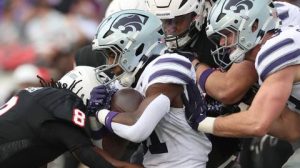
After a disappointing 41-0 loss to Houston, Kansas State head coach Chris Klieman didn’t mince words when it came to his team’s struggles on the ground. The Wildcats’ rushing attack, which had been a hallmark of their offense earlier in the season, was a major point of frustration for Klieman, who pointed to the lack of execution as a key factor in the defeat.

In the game against Houston, K-State managed only 89 rushing yards on 34 carries, averaging a meager 2.6 yards per attempt. It wasn’t just the result, but the way it unfolded. Klieman noted that the issues had been creeping up in previous weeks, even in wins over Kansas and West Virginia. Despite getting by with a few explosive plays, Klieman believes the Wildcats have been lacking the necessary fundamentals, particularly in the offensive line’s ability to sustain and finish blocks.
“We’re not playing with good enough fundamentals and techniques,” Klieman said after the loss. “We’ve been able to overcome it a little bit with an explosive play here and there, but it’s the same thing we talked about after the Kansas game. We’re not good enough at identifying blocks, sustaining blocks, finishing blocks, and when we do, we’ve got to run through arm tackles. And right now, we’re not doing that well at all.”
This downturn in rushing performance is alarming for a program that entered the season with high expectations for its ground game. K-State had been touted as one of the most explosive rushing teams in college football, and running back DJ Giddens had lived up to that billing early in the season. Through his first six games, Giddens was averaging an impressive 7.3 yards per carry. However, over the past three games, including the loss to Houston, Giddens has struggled to find space. Aside from a 54-yard run against Kansas, he has averaged just 2.9 yards per carry.
Dylan Edwards, who had been a solid complementary back earlier in the season, was similarly ineffective against the Cougars, finishing with just 31 yards on 8 carries. The struggles extended to quarterback Avery Johnson, who had been a dual-threat weapon for K-State early in the year. Johnson averaged 7.3 yards per carry in the first few games but has seen his rushing effectiveness decline after an injury against Colorado. Over the past four games, Johnson has rushed for just 70 yards on 29 carries, averaging a dismal 2.4 yards per run. Against Houston, Johnson appeared hesitant and lacked the explosiveness that had defined his early performances.
The decline in the running game has been exacerbated by opposing defenses’ strategies. Teams like Kansas, West Virginia, and Houston have focused heavily on stopping K-State’s run game, particularly Giddens. The Wildcats’ offensive line has struggled to handle stunts and pressures up front, limiting the team’s ability to establish a consistent rushing attack.
“People are doing some stunts and pressures against us,” Klieman said. “We are struggling to identify it and get it blocked up. When you do that, you’re not running the football.”
As K-State prepares for a bye week before returning to action against Arizona State on November 16, questions remain about how the Wildcats will adjust their approach. Offensive coordinator Conor Riley, a former offensive lineman with a penchant for running the ball, will need to find a way to get his unit back on track. With a rushing attack that had been the backbone of K-State’s offensive success, finding a solution in the trenches will be crucial for the Wildcats to regain their identity and become a threat once again on the ground.
It’s clear that changes are needed up front, and Klieman is hopeful that improvements will come as the team regroups. With the pressure mounting and the season entering its final stretch, K-State’s ability to rediscover its rushing game could determine whether the Wildcats can make a run in the Big 12.
Discover more from INNERNEWSPORT
Subscribe to get the latest posts sent to your email.



